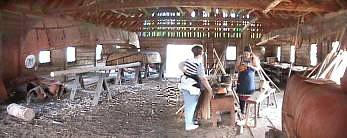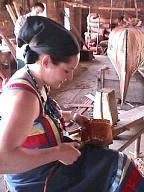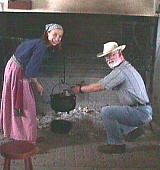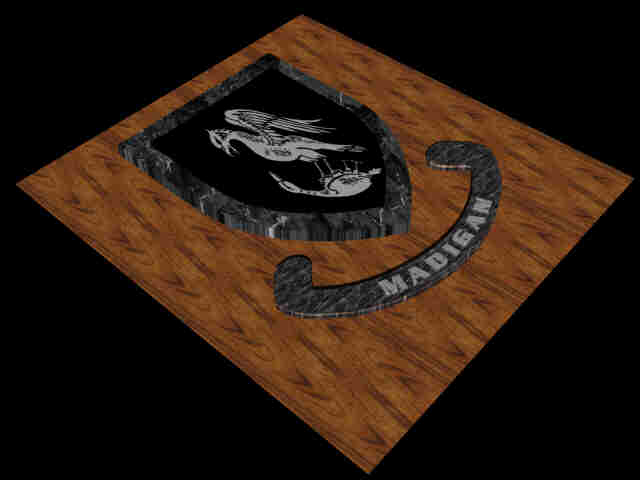From here we crossed the courtyard to the great
hall. This was the center of activity for the aristocrats that
frequented the Fort. Often found dressed in top hats and coat
tails, these gentlemen lived in luxury, dining on fine china and
consuming delicate wines brought up by the schooners. As we
entered the room three of the gentlemen were engaged in a
spirited conversation about the seating arrangements for the
nights dinner. We quickly found ourselves sucked into the debate
as we were challenged as to our heritage and given a proper
seating assignment. The building was also the center for dances
and other forms of
here we crossed the courtyard to the great
hall. This was the center of activity for the aristocrats that
frequented the Fort. Often found dressed in top hats and coat
tails, these gentlemen lived in luxury, dining on fine china and
consuming delicate wines brought up by the schooners. As we
entered the room three of the gentlemen were engaged in a
spirited conversation about the seating arrangements for the
nights dinner. We quickly found ourselves sucked into the debate
as we were challenged as to our heritage and given a proper
seating assignment. The building was also the center for dances
and other forms of  entertainment enjoyed by the elite. As we left
the gentlemen were still nitpicking at each other over the proper
status of some arriving guest. We headed out to the gunsmiths
where we found Gervais Nolin finishing up some adjustments to one
of the muskets which were traded for pelts. In the background
Francois Marshal carefully replaced a power horn spring. He
actually was quite a craftsman as he showed us a powder horn
which he had carved in scrimshaw-like etchings, producing a
marvelous scene on the side of the container.
entertainment enjoyed by the elite. As we left
the gentlemen were still nitpicking at each other over the proper
status of some arriving guest. We headed out to the gunsmiths
where we found Gervais Nolin finishing up some adjustments to one
of the muskets which were traded for pelts. In the background
Francois Marshal carefully replaced a power horn spring. He
actually was quite a craftsman as he showed us a powder horn
which he had carved in scrimshaw-like etchings, producing a
marvelous scene on the side of the container.  Again it
stuck me that in addition to being actors in the truest sense,
these people were true artisans, producing quality items under
ancient conditions. We moved on to the canoe barn where a larger
than normal transport canoe was being built. The voyager
re-enactments that go one continuously through the summer require
regular maintenance and replacement of these delicate boats.
Birch
Again it
stuck me that in addition to being actors in the truest sense,
these people were true artisans, producing quality items under
ancient conditions. We moved on to the canoe barn where a larger
than normal transport canoe was being built. The voyager
re-enactments that go one continuously through the summer require
regular maintenance and replacement of these delicate boats.
Birch bark is stretched, flattened and then tied to a light wood frame.
The seams are coated with a pitch made from birch gum. Keeping
them watertight is a day to day job, much as it was in the 1800s.
During its heyday, the Fort produced one canoe a week throughout
the working months. The black paste is not the best sealant ever
discovered but it was available and it did the job with proper
care. Needless to say, anytime the canoe hit anything, the pitch
broke away and the canoe took on water. The Indians perfected the
art of canoe making over hundreds of years. It was amazing to
find that he original boats could still be made and floated using
the traditional Indian methods. Our friends admitted that there
is only one remaining master canoe builder left at the park. With
the Fort tour completed we passed out through the back gate to
the palisade and into the farming community that supported it. On
our way we stopped by one of the many houses on display.
bark is stretched, flattened and then tied to a light wood frame.
The seams are coated with a pitch made from birch gum. Keeping
them watertight is a day to day job, much as it was in the 1800s.
During its heyday, the Fort produced one canoe a week throughout
the working months. The black paste is not the best sealant ever
discovered but it was available and it did the job with proper
care. Needless to say, anytime the canoe hit anything, the pitch
broke away and the canoe took on water. The Indians perfected the
art of canoe making over hundreds of years. It was amazing to
find that he original boats could still be made and floated using
the traditional Indian methods. Our friends admitted that there
is only one remaining master canoe builder left at the park. With
the Fort tour completed we passed out through the back gate to
the palisade and into the farming community that supported it. On
our way we stopped by one of the many houses on display. Inside, over
an open fire, Marissa had just completed cooking potato soup, a
staple for the Fort's middle class. This had to be done using
only the basic tools afforded a household for that time period. A
large cauldron over an open fire which was tended by the kids she
was raising. I marveled at the conversation we were having as she
chattered about her life as if we were old friends. As I knelt by
the fire savoring the aroma, I was offered a tin cup for
sampling. Slow cooking had produced a smooth flavorful porridge
with a zesty aftertaste. To my surprise it was a good as anything
I had eaten in a modern day restaurant. The farming community
which actually supports the efforts of the rest of the community
as well as producing much of its own animal feed, is a sprawling
development of barns, stables and storerooms. New born animals
are around for the kids to pet. Sheep wander freely through the
yards. It takes several people in attendance at all times and as
we sat and took in the surroundings we could get the feel of what
life was like in this environment. Several girls were sitting
Inside, over
an open fire, Marissa had just completed cooking potato soup, a
staple for the Fort's middle class. This had to be done using
only the basic tools afforded a household for that time period. A
large cauldron over an open fire which was tended by the kids she
was raising. I marveled at the conversation we were having as she
chattered about her life as if we were old friends. As I knelt by
the fire savoring the aroma, I was offered a tin cup for
sampling. Slow cooking had produced a smooth flavorful porridge
with a zesty aftertaste. To my surprise it was a good as anything
I had eaten in a modern day restaurant. The farming community
which actually supports the efforts of the rest of the community
as well as producing much of its own animal feed, is a sprawling
development of barns, stables and storerooms. New born animals
are around for the kids to pet. Sheep wander freely through the
yards. It takes several people in attendance at all times and as
we sat and took in the surroundings we could get the feel of what
life was like in this environment. Several girls were sitting  with
us preparing spruce root to be used as rope. All the smells and
sounds were bountiful in support of the farming activities. It
was a wonderful experience just to sit there and feel the
existence of farm life. As we wandered back to the car from what
had turned out to be an all day affair I had to give the
presentation the highest marks for authenticity and overall
creation of a feeling rarely witnessed in visiting living
museums. This is a must for anyone desiring to understand the
people and times that produced the Canada as it is known today.
with
us preparing spruce root to be used as rope. All the smells and
sounds were bountiful in support of the farming activities. It
was a wonderful experience just to sit there and feel the
existence of farm life. As we wandered back to the car from what
had turned out to be an all day affair I had to give the
presentation the highest marks for authenticity and overall
creation of a feeling rarely witnessed in visiting living
museums. This is a must for anyone desiring to understand the
people and times that produced the Canada as it is known today.
For more information, visit their website at www.fwhp.ca/homepage.html

 <<<<<
Back Next
>>>>>
<<<<<
Back Next
>>>>> 
 here we crossed the courtyard to the great
hall. This was the center of activity for the aristocrats that
frequented the Fort. Often found dressed in top hats and coat
tails, these gentlemen lived in luxury, dining on fine china and
consuming delicate wines brought up by the schooners. As we
entered the room three of the gentlemen were engaged in a
spirited conversation about the seating arrangements for the
nights dinner. We quickly found ourselves sucked into the debate
as we were challenged as to our heritage and given a proper
seating assignment. The building was also the center for dances
and other forms of
here we crossed the courtyard to the great
hall. This was the center of activity for the aristocrats that
frequented the Fort. Often found dressed in top hats and coat
tails, these gentlemen lived in luxury, dining on fine china and
consuming delicate wines brought up by the schooners. As we
entered the room three of the gentlemen were engaged in a
spirited conversation about the seating arrangements for the
nights dinner. We quickly found ourselves sucked into the debate
as we were challenged as to our heritage and given a proper
seating assignment. The building was also the center for dances
and other forms of  entertainment enjoyed by the elite. As we left
the gentlemen were still nitpicking at each other over the proper
status of some arriving guest. We headed out to the gunsmiths
where we found Gervais Nolin finishing up some adjustments to one
of the muskets which were traded for pelts. In the background
Francois Marshal carefully replaced a power horn spring. He
actually was quite a craftsman as he showed us a powder horn
which he had carved in scrimshaw-like etchings, producing a
marvelous scene on the side of the container.
entertainment enjoyed by the elite. As we left
the gentlemen were still nitpicking at each other over the proper
status of some arriving guest. We headed out to the gunsmiths
where we found Gervais Nolin finishing up some adjustments to one
of the muskets which were traded for pelts. In the background
Francois Marshal carefully replaced a power horn spring. He
actually was quite a craftsman as he showed us a powder horn
which he had carved in scrimshaw-like etchings, producing a
marvelous scene on the side of the container.  Again it
stuck me that in addition to being actors in the truest sense,
these people were true artisans, producing quality items under
ancient conditions. We moved on to the canoe barn where a larger
than normal transport canoe was being built. The voyager
re-enactments that go one continuously through the summer require
regular maintenance and replacement of these delicate boats.
Birch
Again it
stuck me that in addition to being actors in the truest sense,
these people were true artisans, producing quality items under
ancient conditions. We moved on to the canoe barn where a larger
than normal transport canoe was being built. The voyager
re-enactments that go one continuously through the summer require
regular maintenance and replacement of these delicate boats.
Birch bark is stretched, flattened and then tied to a light wood frame.
The seams are coated with a pitch made from birch gum. Keeping
them watertight is a day to day job, much as it was in the 1800s.
During its heyday, the Fort produced one canoe a week throughout
the working months. The black paste is not the best sealant ever
discovered but it was available and it did the job with proper
care. Needless to say, anytime the canoe hit anything, the pitch
broke away and the canoe took on water. The Indians perfected the
art of canoe making over hundreds of years. It was amazing to
find that he original boats could still be made and floated using
the traditional Indian methods. Our friends admitted that there
is only one remaining master canoe builder left at the park. With
the Fort tour completed we passed out through the back gate to
the palisade and into the farming community that supported it. On
our way we stopped by one of the many houses on display.
bark is stretched, flattened and then tied to a light wood frame.
The seams are coated with a pitch made from birch gum. Keeping
them watertight is a day to day job, much as it was in the 1800s.
During its heyday, the Fort produced one canoe a week throughout
the working months. The black paste is not the best sealant ever
discovered but it was available and it did the job with proper
care. Needless to say, anytime the canoe hit anything, the pitch
broke away and the canoe took on water. The Indians perfected the
art of canoe making over hundreds of years. It was amazing to
find that he original boats could still be made and floated using
the traditional Indian methods. Our friends admitted that there
is only one remaining master canoe builder left at the park. With
the Fort tour completed we passed out through the back gate to
the palisade and into the farming community that supported it. On
our way we stopped by one of the many houses on display. Inside, over
an open fire, Marissa had just completed cooking potato soup, a
staple for the Fort's middle class. This had to be done using
only the basic tools afforded a household for that time period. A
large cauldron over an open fire which was tended by the kids she
was raising. I marveled at the conversation we were having as she
chattered about her life as if we were old friends. As I knelt by
the fire savoring the aroma, I was offered a tin cup for
sampling. Slow cooking had produced a smooth flavorful porridge
with a zesty aftertaste. To my surprise it was a good as anything
I had eaten in a modern day restaurant. The farming community
which actually supports the efforts of the rest of the community
as well as producing much of its own animal feed, is a sprawling
development of barns, stables and storerooms. New born animals
are around for the kids to pet. Sheep wander freely through the
yards. It takes several people in attendance at all times and as
we sat and took in the surroundings we could get the feel of what
life was like in this environment. Several girls were sitting
Inside, over
an open fire, Marissa had just completed cooking potato soup, a
staple for the Fort's middle class. This had to be done using
only the basic tools afforded a household for that time period. A
large cauldron over an open fire which was tended by the kids she
was raising. I marveled at the conversation we were having as she
chattered about her life as if we were old friends. As I knelt by
the fire savoring the aroma, I was offered a tin cup for
sampling. Slow cooking had produced a smooth flavorful porridge
with a zesty aftertaste. To my surprise it was a good as anything
I had eaten in a modern day restaurant. The farming community
which actually supports the efforts of the rest of the community
as well as producing much of its own animal feed, is a sprawling
development of barns, stables and storerooms. New born animals
are around for the kids to pet. Sheep wander freely through the
yards. It takes several people in attendance at all times and as
we sat and took in the surroundings we could get the feel of what
life was like in this environment. Several girls were sitting  with
us preparing spruce root to be used as rope. All the smells and
sounds were bountiful in support of the farming activities. It
was a wonderful experience just to sit there and feel the
existence of farm life. As we wandered back to the car from what
had turned out to be an all day affair I had to give the
presentation the highest marks for authenticity and overall
creation of a feeling rarely witnessed in visiting living
museums. This is a must for anyone desiring to understand the
people and times that produced the Canada as it is known today.
with
us preparing spruce root to be used as rope. All the smells and
sounds were bountiful in support of the farming activities. It
was a wonderful experience just to sit there and feel the
existence of farm life. As we wandered back to the car from what
had turned out to be an all day affair I had to give the
presentation the highest marks for authenticity and overall
creation of a feeling rarely witnessed in visiting living
museums. This is a must for anyone desiring to understand the
people and times that produced the Canada as it is known today.
